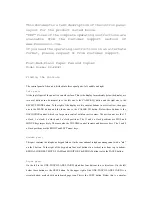
and strikes the fold table paper stop. The sheet then enters
between the second and third folding roller where the first fold
is made. The sheet then enters the second/lower folding table
and strikes the fold table paper stop. The sheet enters between
the third and fourth folding rollers where the second fold is
made. The folded sheet then enters between the upper and lower
accessory guide rollers and exits onto the conveyor table. The
sheets are stacked in an overlapping formation as they travel to
the receiving tray.
Although your folder was thoroughly tested and precision
adjusted before shipment, mis-handling during shipment may
necessitate readjustment. We recommend checking these adjust-
ments before you attempt to operate the folder. See Sections 5.2
& 5.3 in this manual.
4.2 Operational Setup
4.2.1 Setting The Sheet Detector
See Parts Diagram.
The sheet detector block assembly (Item 7) is mounted on the
tie rod (Item 73) directly above the vacuum roller. The assembly
consists of a sheet detector block with one block and one nose
pipe set screw, the nose pipe (Item 11), the sheet detector (Item
10), and the locking knob and washer (Item 8 & 9).
The function of the sheet detector is to limit the number of
sheets (1, 2, or 3) entering the folding rollers. The height of the
sheet detector determines the number of sheets entering the
folding rollers, based on the thickness of the sheet(s).
To set the sheet detector, cut a strip of paper 1 3/4" wide and 6"
long from the stock to be folded. Fold the strip in half (1 3/4" x
3"). This strip is the correct thickness and dimension for setting
the gap between the sheet detector and vacuum roller.
Make sure the sheet detector cannot contact the vacuum roller.
Using the hand wheel, rotate the vacuum roller until the sheet
detector will contact the roller on the flat surface between the
countersunk holes. Place the non-folded end of the folded strip
of paper on the vacuum roller between the two rubber rings
(Item 4A). Lower the sheet detector onto the paper strip and
lock into position. See Figure 5.
NOTE: Do not force the sheet detector onto the paper
strip when tightening the knob.
Move the paper strip left to right and check the setting. Verify
each leg is the same height. The sheet detector is correctly set
when a light contact is felt between the the detector, paper, and
vacuum roller. The correct setting of the sheet detector is impor-
tant and will require practice. If the setting is too loose, more
than one sheet may enter the folding rollers. If the setting is too
tight, no sheets may enter, or intermittent feeding may occur.
The sheets that do advance into the rollers may have marks or
“flecks” on the leading edge.
NOTE: Because paper thicknesses vary and because
of normal wear (See Figure 5.), the sheet detector gap
must be set or reset each time the folder is used.
4.2.2 Feed Table Setup And Paper Loading
CAUTION: Never handle the feed table by the left or
right paper guides. Doing so may cause misalign-
ment of the guides and subsequent folding problems.
The feed table assembly consists of the left paper guide (Item
5C), the right paper guide (Item 5B), the paper guide rod (Item
5A), and the paper centering scale. The paper guides are
attached to aluminum guide blocks. The guide blocks are “V”
slotted. The paper guide rod is inserted through the “V” ways in
the blocks and the guide blocks are locked to the guide rod via
locking knobs.
To set the paper guides for the required paper width, loosen the
locking knobs 1/4 to 1/2 turn. Slide each guide to the required
width as indicated on the centering scale. The centering scale is
located at the front edge of the feed table. (See Figure 6.)
Retighten the locking knob. (The paper guide rod and paper
guides are also adjusted in the field alignment procedure. See
Section 5.3. )
After the paper guides are set, place one sheet of paper between
the paper guides. The sheet should slide freely down between
the guides without excessive side play or binding. Readjust the
right/operators' side paper guide, if necessary until the sheet
slides freely.
NOTE: The paper guides must be set correctly.
Incorrect setting may cause inconsistent, inaccurate,
or wrinkled folds.
Place a 2" stack of the paper to be folded into an Martin Yale
Model 400 or Model 4200 Jogger. Jog the paper for about one
minute. Jogging dissipates static electricity, aligns the edges,
and helps keep sheets from sticking together. Place a 1/2" to
3/4" stack of jogged paper onto the feed table.
4.2.3 Fold Table Setup
See Figures 6, 7, and 8.
Each fold table assembly consists
of an upper and lower fold plate,
an aluminum deflector bar (Item
71N), two fold indicator rulers
(Item 71O), an adjustable paper
stop (Item 71C) with split nut and
locking screw (Item 71M), two
micrometer adjustment screws
(Item 71I) with spring washers
and lock nuts, and adjusting
wheels. (See Figure 10.) Each
fold table has an open/folding
end, and a closed/deflector end.
The job being processed determines how the fold table is
mounted to the machine. See Section 4.3, Fold Settings, and
Section 4.4, Perforating, Scoring, & Slitting.
5
Fig. 6
Содержание 959AF
Страница 18: ...18 Parts Diagram 1 ...
Страница 19: ...19 ...






































